

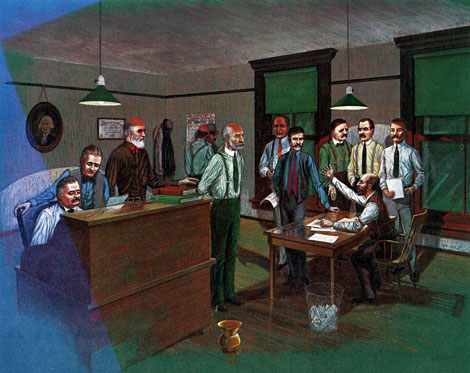 Salt River Valley Users Association Meeting as painted by C. Kemper, 1980. L to R: J.kibbey, P.T. Hurley, W. Christy, H. Simkins, W. Wallace, B.A. Fowler, A.J. Chandler, F. Parker, L. Orme, D. Heard, F. Alkire (seated), G. Maxwell. (Courtesy of Salt River Project)
Salt River Valley Users Association Meeting as painted by C. Kemper, 1980. L to R: J.kibbey, P.T. Hurley, W. Christy, H. Simkins, W. Wallace, B.A. Fowler, A.J. Chandler, F. Parker, L. Orme, D. Heard, F. Alkire (seated), G. Maxwell. (Courtesy of Salt River Project)One of the first five projects authorized under the Reclamation Act was the Salt River Project (http://www.usbr.gov/projects/Project.jsp?proj_Name=Salt%20River%20Project) in Arizona Territory. The cornerstone of the project was a new dam downstream of the confluence of Tonto Creek and the Salt River, a location identified as early as 1889 as the ideal location for a dam. Although it received stiff competition from another dam to be constructed on the Gila River where it crosses through the San Carlos Apache Reservation, it was selected for several reasons, not the least of which was the formation of the Salt River Valley Water Users Association. The U.S. Reclamation Service had stipulated that before a project could be authorized, local landowners and other interests had to resolve all their differences and create a landowners' association. With the formation of the Association, 4,800 individual landowners pledged 200,000 acres of lands as collateral. Project costs would be paid back to the government by the Association out of water and power revenues, once the system was fully operational. The Association ensured that rights to stored water would be equally available to all members, construction costs and assessments would be evenly distributed, and the creation of a central utility concern (at a later date) would be responsible for project maintenance.
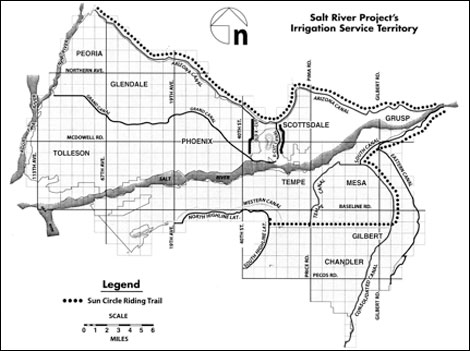 SRP Canals, Courtesy of Salt River Project
SRP Canals, Courtesy of Salt River ProjectThe Association would also negotiate with the Reclamation Service over problems and issues, guarantee the repayment of construction costs to the government, and enforce payment collection from local landowners. These new procedures and requirements represented a major change for irrigation in the Salt River Valley. No longer would individuals divert the water they needed at will, nor would one or a handful of powerful local farmers dictate management policy. From here on, all valley water resources would be centrally managed and, as a result, the decision-making role of the individual landowner would decline in relative importance. With the Association in place and all requirements penned, Arizona's Salt River Project was authorized on March 14, 1903, by Interior Secretary Ethan A. Hitchcock in accordance with the National Reclamation Act of June 17, 1902.
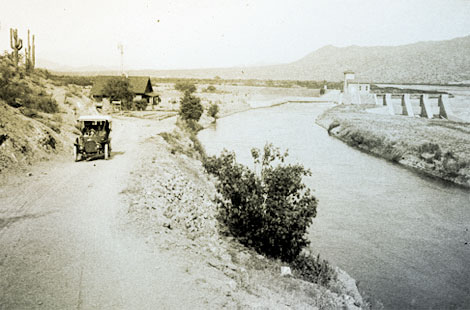 Granite Reef Diversion Dam with outlet for the Arizona Canal around 1910. (Reclamation photograph)
Granite Reef Diversion Dam with outlet for the Arizona Canal around 1910. (Reclamation photograph)
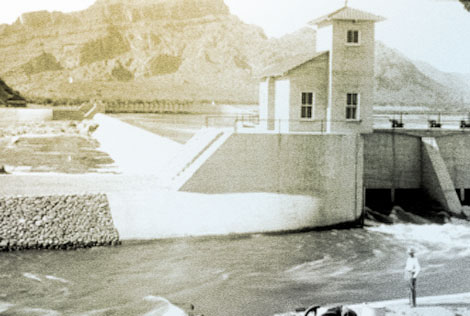 Granite Reef Diversion replaced the crude rock and brush dams that washed out in floods, providing a reliable structure to divert water into the Arizona and South canal, 1910. (Reclamation photograph)
Granite Reef Diversion replaced the crude rock and brush dams that washed out in floods, providing a reliable structure to divert water into the Arizona and South canal, 1910. (Reclamation photograph)The Reclamation Service and the Association established three important goals: build the Salt River storage dam Dr. Chandler and others had envisioned over the previous two decades, construct a dependable canal diversion dam (Granite Reef) downstream from the storage dam to replace the crude rock and brush diversion structures that usually washed away in floods, and have the government purchase, improve, and expand the private canal system. In charge of the project were supervising engineer Louis C. Hill, Reclamation chief engineer Arthur Powell Davis, and design engineer Fred Teichman, with Reclamation Director Frederick Newell overseeing the project's progress. Progress was paramount, because the new storage facility, named Roosevelt Dam in honor of the President, would serve as an icon of the new Reclamation Service's engineering and construction expertise.
Today, the Salt River Valley Water Users Association is better known as SRP, the Salt River Project (http://www.srpnet.com/about/history/default.aspx).
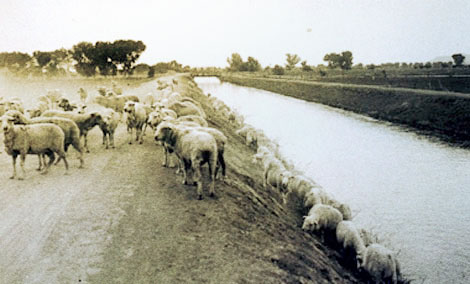 Canal maintenance was an on-going problem, and Government sheep were used to control weeds and grass along the canals, 1914. (Reclamation photograph)
Canal maintenance was an on-going problem, and Government sheep were used to control weeds and grass along the canals, 1914. (Reclamation photograph)